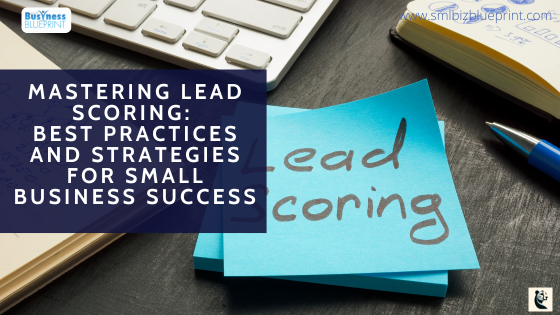Mastering lead scoring can significantly enhance your sales and marketing efforts, ensuring you focus on the most promising prospects.
Lead scoring is a methodology that ranks potential customers based on their perceived value to your organisation. It helps you prioritise leads and streamline your sales process.
This blog post will delve into the best practices for lead scoring, including defining and prioritising criteria, integrating with your CRM system, enhancing with behavioural data, and aligning sales and marketing teams.
These strategies can improve lead conversion rates, optimise your marketing efforts, and drive business growth.

#1 What is Lead Scoring, and Why is it Important?
Lead scoring is a crucial process that helps businesses prioritise their leads based on their potential value.
It involves assigning numerical values to prospects based on specific criteria, such as demographics, behaviour, and engagement levels. This system allows sales and marketing teams to focus on leads that are more likely to convert, ensuring a more efficient and effective sales process.
Definition of Lead Scoring
Lead scoring is a method for ranking prospects against a scale that signifies each lead’s perceived value to the organisation. Businesses can determine which leads will likely become customers by assigning points based on various attributes and behaviours.
This process helps streamline sales efforts, ensuring time and resources are spent on the most promising leads.
Explanation of How Lead Scoring Helps Prioritize Leads
The primary goal of lead scoring is to prioritise leads so that sales teams can focus on those with the highest potential for conversion. High-scoring leads are typically further along in the buyer’s journey and exhibit behaviours that indicate a strong interest in your products or services.
These behaviours include frequent visits to your website, downloading resources, or engaging with your emails. By identifying these high-value leads, sales teams can allocate their time and resources more effectively, leading to higher conversion rates and a more efficient sales process.
Impact on Sales and Marketing Alignment
One of the most significant benefits of lead scoring is its alignment between sales and marketing teams. When both teams use a common framework for evaluating lead quality, it ensures everyone is on the same page regarding prioritising leads.
This alignment helps to reduce friction between departments. Marketing can generate leads that meet the criteria established by sales, and sales can trust that the leads passed on to them are genuinely worth pursuing.
Importance of Lead Scoring Best Practices
Implementing lead scoring best practices is essential for ensuring the accuracy and effectiveness of your lead scoring model. Without a well-defined approach, your lead scoring system might be inconsistent or fail to reflect your leads’ potential value accurately.
By adhering to best practices, such as regularly reviewing and updating your scoring criteria, integrating lead scoring with your CRM system, and leveraging demographic and behavioural data, you can create a robust lead scoring model that drives better results for your business.
In summary, lead scoring is a powerful tool that helps businesses prioritise their leads, align their sales and marketing efforts, and improve their conversion rates.
By understanding lead scoring and its importance, you can implement a lead scoring system that enhances your sales process and drives business success.
#2 Defining and Prioritizing Lead Scoring Criteria
Defining and prioritising lead-scoring criteria is fundamental in creating an effective lead-scoring model. This process involves identifying the characteristics and behaviours that indicate a lead’s likelihood to convert into a customer.
By carefully selecting and prioritising these criteria, you can ensure that your lead scoring system accurately reflects each lead’s potential value.
Steps to Define Lead Scoring Criteria
To define your lead scoring criteria, follow these steps:
Identify Key Characteristics of High-Value Customers:
Analyse your existing customer base to identify common traits among your most valuable customers. This can include demographic information (such as job title, company size, and industry) and behavioural data (such as website visits, content downloads, and email engagement).
Collaborate with Sales and Marketing Teams:
Engage both sales and marketing teams to gather insights and ensure alignment. Sales teams can provide valuable feedback on the types of leads that have historically converted well, while marketing can offer insights into lead behaviours and engagement patterns.
Determine the Most Critical Attributes:
Prioritise the attributes that most strongly correlate with successful conversions. This will help you focus your scoring efforts on the most important factors.
Importance of Demographic and Behavioral Data
Both demographic and behavioural data play a crucial role in lead scoring. Here’s why:
Demographic Data:
This includes static information about your leads, such as their job title, industry, company size, and location. These attributes help you understand who your leads are and whether they fit your ideal customer profile.
Example: A lead with the ” Director ” job title at a mid-sized company in your target industry might receive a higher score.
Behavioural Data:
This involves tracking the actions that lead take, such as visiting your website, opening emails, downloading content, and attending webinars. These behaviours indicate a lead’s interest and engagement with your brand.
Example: A lead who visits your pricing page multiple times and downloads several whitepapers will likely be more sales-ready and should receive a higher score.
Examples of Effective Lead Scoring Criteria
Effective lead scoring criteria should reflect the characteristics and behaviours most predictive of a lead’s likelihood to convert.
Here are some examples:
- Job Title: Manager (10 points), Director (15 points), Executive (20 points)
- Company Size: Small (5 points), Medium (10 points), Large (15 points)
- Industry: Target Industry (20 points), Related Industry (10 points), Non-Target Industry (0 points)
- Website Visit Frequency: 1-2 times per week (5 points), 3+ times per week (20 points)
- Content Downloads: 1-2 downloads (10 points), 3+ downloads (25 points)
Key Components of a Lead Scoring Model
A robust lead-scoring model includes several key components:
Point System: Assign numerical values to each criterion based on its importance.
Thresholds for MQLs (Marketing Qualified Leads): Determine the score at which a lead is considered marketing qualified and ready to be passed to sales.
Criteria for Disqualification: Identify factors that would disqualify a lead, such as being in a non-target industry or having a job title outside your focus.
By carefully defining and prioritizing your lead scoring criteria, you can create a model that accurately reflects the potential value of your leads. This will ensure that your sales team focuses on the most promising prospects.
This approach improves conversion rates and aligns your sales and marketing efforts, driving overall business success.
#3 Integrating Lead Scoring with Your CRM System
Integrating lead scoring with your CRM system is essential for maximising the efficiency and effectiveness of your lead management process. A well-integrated system ensures that all lead information is up-to-date, accessible, and actionable for both sales and marketing teams.
Here’s how to integrate lead scoring seamlessly with your CRM system and the benefits of doing so.
Benefits of Integrating Lead Scoring with CRM
Integrating lead scoring with your CRM system offers several advantages:
Real-Time Updates and Seamless Tracking:
The integration allows for real-time updates on lead scores based on their latest interactions and behaviours. This ensures that sales and marketing teams always have the most current information when making decisions.
Example: When a lead downloads a new whitepaper or attends a webinar, their score is immediately updated in the CRM, allowing sales to prioritise follow-up.
Better Segmentation and Targeted Communication:
With integrated lead scoring, you can more effectively segment leads based on their scores and tailor your communication strategies accordingly. This leads to more personalised and relevant outreach.
Example: High-scoring leads might receive more direct sales calls while mid-scoring leads might be nurtured with targeted email campaigns.
Steps for Seamless CRM Lead Scoring Integration
Follow these steps to integrate lead scoring with your CRM system:
Choose the Right CRM Platform:
Select a CRM system that supports lead scoring through built-in capabilities or third-party integrations.
Map Lead Scoring Criteria to CRM Fields:
Ensure that the lead scoring criteria you’ve defined are mapped to corresponding fields in your CRM. This might involve creating custom fields for specific scoring attributes.
Example: Create fields for job title, company size, website visit frequency, and content downloads.
Set Up Automated Workflows:
Configure automated workflows to update lead scores based on lead data and behaviour changes. This might involve setting up triggers and rules within the CRM.
Example: Set a trigger to add points when a lead opens a marketing email or visits a key webpage.
Train Your Team:
Ensure that both sales and marketing teams understand the integrated system. Provide training on interpreting lead scores and taking appropriate actions based on them.
Best Practices for Setup and Ongoing Maintenance
To maintain the effectiveness of your integrated lead scoring system, follow these best practices:
Regularly Audit and Update Scoring Criteria:
Periodically review your lead scoring criteria to ensure they remain relevant and aligned with your business goals. Adjust point values and criteria as needed based on performance data.
Example: If certain behaviours indicate a lead’s readiness to buy, increase the points assigned to those behaviours.
Ensure Data Integrity and Accuracy:
Automated tools and processes are used to validate and cleanse lead data. Accurate data is crucial for reliable lead scoring.
Example: Implement data validation rules to check for incomplete or incorrect information when leads are entered into the CRM.
Tips for Ensuring Data Accuracy and Consistency
Maintaining accurate and consistent data is vital for effective lead scoring. Here are some tips:
Use Automated Tools for Data Validation and Cleansing:
Employ tools that can automatically check for and correct data errors. This might include duplicate detection, standardising data formats, and verifying contact information.
Example: Use a CRM plugin that automatically merges duplicate leads and standardises job titles.
Regularly Review and Update Lead Information:
Set up processes for regular data review and updates. This will ensure lead scores are based on the most current and accurate information.
Example: Schedule quarterly audits to verify and update lead information in the CRM.
Integrating lead scoring with your CRM system streamlines your lead management process, ensures data accuracy, and enhances communication between sales and marketing teams.
These steps and best practices can create a seamless, effective lead-scoring system that drives better business results.

#4 Enhancing Lead Scoring with Behavioral Data
Behavioural data is crucial in refining and enhancing your lead scoring model. You can gain deeper insights into their interest and readiness to purchase by tracking and analysing your leads’ actions and interactions.
This section will explore effectively utilising behavioural data in your lead scoring process.
Explanation of Behavioral Data in Lead Scoring
Behavioural data refers to the actions that leads take in their interactions with your brand. These actions provide valuable insights into their engagement and interest levels.
Common examples of behavioural data include website visits, email opens, content downloads, social media interactions, and webinar attendance. Incorporating these behaviours into your lead scoring model helps you assess a lead’s intent and likelihood to convert more accurately.
Examples of Valuable Behavioral Data Points
Here are some key behavioural data points to consider for your lead-scoring model:
Website Visits:
The frequency and depth of a lead’s visits to your website can indicate interest. Multiple visits to high-value pages, such as pricing or product pages, can signal purchase readiness.
Example: Assign higher scores to leads who visit your pricing page multiple times.
Email Engagement:
Opens, clicks, and responses to your email campaigns provide insights into a lead’s engagement with your content.
Example: Add points for each email open and click-through, with higher points for emails that link to key content.
Content Downloads:
Leads downloading whitepapers, case studies, or other valuable content demonstrate a deeper interest in your offerings.
Example: Assign more points to leads who download multiple pieces of content or high-value assets.
Social Media Interactions:
Likes, shares, and comments on your social media posts can indicate interest and engagement.
Example: Add points for social media interactions, with higher scores for comments and shares.
Webinar Attendance:
Participation in webinars or live events shows a strong interest in your brand and products.
Example: Assign significant points to leads who register for and attend webinars.
Techniques to Collect and Analyze Behavioral Data
Collecting and analysing behavioural data involves using various tools and techniques to track lead interactions.
Here are some methods:
Web Analytics Tools:
Utilise tools like Google Analytics to track website visits, page views, and user behaviour on your site.
Example: Use Google Analytics to monitor which pages leads visit and how frequently.
Email Marketing Platforms:
Leverage email marketing platforms to track email opens, clicks, and other engagement metrics.
Example: Set up tracking for email campaigns to capture engagement data and integrate it with your CRM.
CRM Systems:
Ensure your CRM system can capture and store behavioural data from various touchpoints, integrating it into the lead scoring model.
Example: Configure your CRM to automatically update lead scores based on email interactions and website visits.
Social Media Monitoring Tools:
Use tools to track social media interactions and engagement metrics.
Example: Monitor social media activity and assign scores based on the level of engagement.
Benefits of Using Behavioral Data to Refine Lead Scoring
Incorporating behavioural data into your lead-scoring model offers several benefits:
Deeper Insights into Lead Intent:
Behavioural data provides a more nuanced understanding of a lead’s interest and buying readiness, allowing for more accurate scoring.
Example: A lead who repeatedly visits your product pages and downloads multiple whitepapers is likely more sales-ready than a lead who only subscribes to your newsletter.
Enhanced Accuracy of Lead Scores:
Combining demographic and behavioural data can create a more comprehensive and accurate lead-scoring model.
Example: A lead with the right job title and significant engagement with your content will score higher, ensuring they are prioritised correctly.
Better-Targeted Follow-Ups:
Behavioural data helps sales teams tailor follow-up strategies based on a lead’s specific actions and interests.
Example: A lead engaged with specific product-related content can be targeted with more relevant follow-up messages.
Enhancing your lead scoring model with behavioural data allows you to gain deeper insights into lead engagement, improve the accuracy of your scores, and create more targeted follow-up strategies.
By effectively collecting and analysing this data, you can refine your lead-scoring process and drive better business results.
#5 Reviewing and Updating Your Lead Scoring Model
Regularly reviewing and updating your lead scoring model is essential for maintaining its accuracy and relevance. As market conditions, customer behaviours, and business goals evolve, so should your lead-scoring criteria.
This section outlines the importance of periodic reviews, steps for updating your model, common mistakes to avoid, and tips for continuous improvement.
Importance of Regularly Reviewing Lead Scoring Models
A lead scoring model that remains static can quickly become outdated and ineffective.
Regular reviews ensure that your scoring criteria continue to reflect the most predictive factors for lead conversion. This helps maintain the accuracy of your lead prioritisation and keeps your sales and marketing teams aligned with current business objectives.
Steps for Updating and Refining the Model
To keep your lead scoring model effective, follow these steps for updating and refining it:
Analyse Performance Data:
Review historical data to understand which criteria have been most predictive of conversions. Identify patterns and trends that indicate changes in lead behaviour or market dynamics.
Example: If leads who attend webinars are increasingly likely to convert, consider increasing the points assigned to webinar attendance.
Solicit Feedback from Sales and Marketing Teams:
Engage with both teams to gather insights on the effectiveness of the current model. Sales teams can provide firsthand feedback on lead quality, while marketing can offer insights into lead engagement patterns.
Example: Sales might report that leads with high engagement in specific content areas convert more frequently, suggesting a need to adjust scoring criteria.
Adjust Weights and Thresholds:
Adjust your lead scoring model’s point values and thresholds based on your analysis and feedback. Ensure that the changes reflect current lead behaviours and business priorities.
Example: Increase points for high-value behaviours such as multiple content downloads or repeat visits to product pages.
Test and Validate Changes:
Implement changes on a small scale to test their impact. Monitor the results to ensure that the updated model accurately prioritises leads and improves conversion rates.
Example: Roll out changes to a subset of leads and track conversion metrics before applying them to the entire lead pool.
Document and Communicate Updates:
Document any changes to the lead scoring model and communicate them to all relevant stakeholders. Ensure that sales and marketing teams know the updates and understand their implications.
Example: Provide a detailed explanation of the new criteria and how they impact lead prioritisation.
Common Lead Scoring Mistakes to Avoid
To maintain the effectiveness of your lead scoring model, avoid these common pitfalls:
Overcomplicating the Model:
Including too many criteria can make the model overly complex and difficult to manage. Focus on the most predictive attributes to keep the model streamlined.
Example: Limit criteria to the top behaviours and demographics correlating with conversions rather than trying to account for every possible variable.
Failing to Update Regularly and Validate Data:
An outdated model based on old data can lead to inaccurate lead scores. To ensure its accuracy, regularly update and validate your data.
Example: Schedule quarterly reviews to refresh lead data and adjust scoring criteria as needed.
Ignoring Feedback from Sales and Marketing Teams:
The success of your lead scoring model depends on input from both sales and marketing. Failing to incorporate their feedback can result in a misaligned and ineffective model.
Example: Hold regular meetings to discuss lead quality and make adjustments based on team insights.
Tips for Continuous Improvement and Optimization
To ensure your lead scoring model remains effective, follow these tips for continuous improvement:
Monitor Key Performance Indicators (KPIs):
Track KPIs such as conversion rates, lead velocity, and sales cycle length to assess the impact of your lead scoring model. Use these metrics to identify areas for improvement.
Example: If conversion rates drop, analyse the scoring criteria to identify potential issues and make necessary adjustments.
Stay Informed About Market and Industry Trends:
Keep abreast of changes in your industry and market conditions. Adapt your lead scoring model to reflect these trends and maintain its relevance.
Example: If a new marketing channel becomes popular, consider incorporating related engagement behaviours into your scoring model.
Foster a Culture of Continuous Feedback:
Encourage ongoing communication between sales and marketing teams to gather real-time feedback on lead quality and scoring effectiveness. Use this feedback to make incremental improvements.
Example: Implement a feedback loop where sales regularly report back on the quality of leads generated by marketing.
Regularly reviewing and updating your lead scoring model ensures that it remains accurate, relevant, and effective.
Following these steps and best practices, you can continuously refine your model, avoid common pitfalls, and drive better business results.
#6 Measuring the Success and ROI of Lead Scoring
Measuring the success and ROI (Return on Investment) of your lead-scoring efforts is crucial for understanding the effectiveness of your strategies and justifying the resources allocated to them.
This section will discuss key metrics to track, methods to calculate ROI, examples of successful implementations, and tools and software recommendations.
Key Metrics to Track for Lead Scoring Effectiveness
To evaluate the success of your lead scoring model, focus on the following key metrics:
Conversion Rates:
The percentage of leads that move from one stage of the sales funnel to the next. High conversion rates indicate that your lead scoring model effectively identifies sales-ready leads.
Example: Track the conversion rate from Marketing Qualified Leads (MQLs) to Sales Qualified Leads (SQLs) and from SQLs to closed deals.
Lead Velocity:
The speed at which leads progress through the sales funnel. Faster lead velocity suggests that your scoring model accurately prioritises high-quality leads, resulting in quicker sales cycles.
Example: Measure the average time leads move from initial contact to becoming a customer.
Sales Cycle Length:
The average duration of your sales process. A shorter sales cycle indicates that your lead scoring model is helping to identify and focus on high-potential leads.
Example: Compare the sales cycle length for scored leads versus non-scored leads.
Lead Score Accuracy:
The correlation between lead scores and conversion outcomes helps you determine whether your scoring criteria accurately predict lead quality.
Example: Analyze the conversion rates of leads with high and low scores.
Methods to Calculate the ROI of Lead Scoring Efforts
To calculate the ROI of your lead-scoring efforts, consider the following methods:
Revenue Attribution:
Measure the revenue generated from leads that were prioritised through lead scoring. Compare this with the revenue from leads that were not scored or had lower scores.
Example: If lead scoring resulted in an additional $100,000 in revenue and the cost of implementing the system was $10,000, the ROI would be ($100,000 – $10,000) / $10,000 = 9, or 900%.
Cost Savings:
Calculate the cost savings from improved efficiency and reduced waste. This includes the time and resources saved by sales teams focusing on high-quality leads.
Example: If lead scoring reduces the time spent on low-quality leads by 20%, and the average cost per sales hour is $50, calculate the total savings.
Customer Acquisition Cost (CAC):
Determine the impact of lead scoring on your CAC by comparing the cost of acquiring customers before and after implementing lead scoring.
Example: If CAC dropped from $500 to $400 after implementing lead scoring, this represents a significant cost saving.
Measuring the success and ROI of your lead-scoring efforts is vital for optimising your sales and marketing strategies.
By tracking key metrics, calculating ROI, learning from successful implementations, and leveraging the right tools, you can ensure that your lead-scoring model drives significant value for your business.

#7 Aligning Sales and Marketing Teams Around Lead Scoring
Aligning sales and marketing teams around lead scoring is crucial for maximising the effectiveness of your lead management process. When both teams work together with a common understanding of lead quality and priorities, it results in improved communication, higher conversion rates, and a more efficient sales cycle.
This section will explore strategies to ensure alignment, the benefits of a unified approach, examples of successful collaboration, and best practices for maintaining alignment and communication.
Strategies to Ensure Sales and Marketing Alignment
To achieve alignment between sales and marketing teams, consider the following strategies:
Establish Shared Goals and Metrics:
Define common objectives and key performance indicators (KPIs) that both teams are responsible for achieving. This fosters a sense of shared responsibility and accountability.
Example: Set a joint goal for increasing the conversion rate of Marketing Qualified Leads (MQLs) to Sales Qualified Leads (SQLs) by 20%.
Regular Cross-Departmental Meetings:
Schedule regular meetings between sales and marketing teams to discuss lead quality, review performance data, and adjust the lead scoring model as needed.
Example: Hold weekly or bi-weekly meetings to review the pipeline, share insights, and align on upcoming campaigns.
Develop a Service Level Agreement (SLA):
Create an SLA that outlines each team’s roles and responsibilities, including lead handoff processes, follow-up timelines, and feedback loops.
Example: Define criteria for MQLs and SQLs and establish a timeline for sales to follow up on leads passed from marketing.
Use a Common Lead Scoring Framework:
Ensure both teams understand and agree on the lead scoring criteria and how points are assigned. This consistency helps avoid misunderstandings and ensures leads are evaluated uniformly.
Example: Provide training sessions for both teams on the lead scoring model and its implementation.
Benefits of a Unified Approach to Lead Scoring
Aligning sales and marketing teams around lead scoring offers several benefits:
Improved Lead Quality:
Marketing can generate higher-quality leads that meet sales criteria, leading to better conversion rates.
Example: Marketing can tailor campaigns to attract the right prospects by clearly understanding what constitutes a high-quality lead.
Enhanced Communication and Collaboration:
Regular interactions and shared goals foster better team communication and collaboration, reducing friction and misunderstandings.
Example: Joint meetings help both teams stay informed about each other’s activities and priorities.
Increased Efficiency and Productivity:
A unified approach ensures that resources are focused on the most promising leads, leading to a more efficient sales process and shorter sales cycles.
Example: Sales teams can prioritise follow-ups based on lead scores, ensuring they focus on leads with the highest potential.
Use Collaborative Tools and Platforms:
Implement tools that facilitate communication and collaboration, such as CRM systems, project management software, and communication platforms.
Example: Use a CRM system like Salesforce or HubSpot to provide both teams visibility into lead status and activities.
Foster a Culture of Continuous Feedback:
Encourage ongoing feedback from both teams to identify areas for improvement and adjust the lead scoring model as needed.
Example: Create a feedback loop in which sales provides regular insights on lead quality, and marketing adjusts its strategies accordingly.
Celebrate Joint Successes: Recognize and celebrate achievements that result from effective collaboration. This reinforces the importance of teamwork and motivates both teams to continue working together.
Example: Share success stories in team meetings or internal newsletters to highlight the impact of alignment efforts.
Aligning sales and marketing teams around lead scoring is essential for maximising lead management efficiency and driving business success.
By implementing these strategies, fostering collaboration, and maintaining open communication, you can ensure that both teams work together effectively to prioritise high-quality leads and achieve common goals.
#8 Strategies for Nurturing Low-Scoring Leads
Nurturing low-scoring leads is an essential component of a comprehensive lead management strategy. While these leads may not be ready to convert immediately, they hold the potential for future sales with proper nurturing.
This section explores the importance of nurturing low-scoring leads, effective follow-up strategies, techniques for re-engaging and warming up leads, and successful case studies.
Importance of Nurturing Low-Scoring Leads
Although low-scoring leads may not currently exhibit strong buying signals, they can still represent valuable opportunities for your business.
Proper nurturing helps keep your brand top-of-mind and builds relationships over time, increasing the likelihood of conversion when these leads are ready to buy.
Ignoring low-scoring leads means missing out on potential future sales and wasting marketing efforts.
Effective Follow-Up Strategies for Low-Scoring Leads
To effectively nurture low-scoring leads, consider the following follow-up strategies:
Personalised Email Campaigns:
Use personalised emails to maintain engagement with low-scoring leads. Tailor content to their interests and behaviours, providing value and fostering a connection.
Example: Send a monthly newsletter with industry insights, product updates, and personalised recommendations based on their past interactions.
Educational Content:
Provide content that addresses common pain points and offers solutions. This helps build trust and positions your brand as a valuable resource.
Example: Create a series of informative blog posts, eBooks, or webinars that address relevant topics for your leads.
Targeted Offers and Promotions:
Occasionally offer targeted promotions or discounts to re-engage low-scoring leads and encourage further interaction with your brand.
Example: Send an exclusive discount code to leads who haven’t engaged in a while and invite them to explore your latest products or services.
Social Media Engagement:
Use social media platforms to maintain visibility and engagement with low-scoring leads. Share relevant content, respond to comments, and participate in conversations to stay connected.
Example: Share case studies, success stories, and industry news on social media, encouraging leads to engage and interact.
Techniques for Re-Engaging and Warming Up Leads
Re-engaging and warming up low-scoring leads involves targeted efforts to reignite their interest and move them closer to conversion.
Here are some effective techniques:
Segmentation and Tailored Messaging:
Segment your low-scoring leads based on their interests, behaviours, and demographics. Craft tailored messages that resonate with each segment’s needs and pain points.
Example: Create segmented email campaigns that address different lead groups’ unique challenges and interests.
Automated Nurturing Campaigns:
Use marketing automation tools to create nurturing campaigns that deliver relevant content and follow-ups based on lead behaviour and engagement.
Example: Set up an automated email sequence that triggers when a lead downloads a resource, gradually nurturing them with related content and offers.
Surveys and Feedback:
Conduct surveys to gather feedback from low-scoring leads about their needs, preferences, and challenges. Use this information to refine your nurturing strategies and provide more relevant content.
Example: Send a brief survey to leads who have been inactive for a while, asking about their current challenges and interests.
Multi-Channel Outreach:
Utilise multiple channels, such as email, social media, and phone calls, to reach and engage low-scoring leads. This ensures a consistent presence and increases the chances of re-engagement.
Example: Follow up a targeted email campaign with a personalised social media message or a phone call to discuss their needs further.
Nurturing low-scoring leads is a vital part of a holistic lead management strategy. You can effectively re-engage and warm up these leads by implementing personalised email campaigns, providing educational content, and using targeted offers.
Leveraging techniques like segmentation, automation, and multi-channel outreach ensures that your nurturing efforts are efficient and effective.
Learning from successful case studies can inspire and guide your own nurturing strategies, ultimately driving higher conversion rates and long-term business success.
Conclusion
Mastering lead scoring is essential for businesses looking to optimise their sales and marketing efforts.
By implementing the best practices outlined in this blog post, you can create a robust lead-scoring system that prioritises high-potential leads, enhances team alignment, and drives business growth.
Here’s a recap of the main points covered:
- What is Lead Scoring, and why is it Important? Understanding the fundamentals of lead scoring helps prioritise leads and streamline your sales process.
- Defining and Prioritising Lead Scoring Criteria: Identifying key characteristics and behaviours that indicate lead quality is crucial for creating an effective scoring model.
- Integrating Lead Scoring with Your CRM System: Seamless integration ensures real-time updates and accurate tracking of lead interactions.
- Enhancing Lead Scoring with Behavioural Data: Incorporating behavioural data provides deeper insights into lead intent and improves scoring accuracy.
- Reviewing and Updating Your Lead Scoring Model: Regular reviews and updates ensure your scoring model remains relevant and effective.
- Measuring the Success and ROI of Lead Scoring: Tracking key metrics and calculating ROI helps evaluate the effectiveness of your lead scoring efforts.
- Aligning Sales and Marketing Teams Around Lead Scoring: Alignment fosters better communication, higher conversion rates, and more efficient sales processes.
- Strategies for Nurturing Low-Scoring Leads: Proper nurturing keeps your brand top-of-mind and builds relationships, increasing the likelihood of future conversions.
By following these best practices and strategies, you can ensure that your lead-scoring efforts are efficient and effective, leading to improved lead management and higher conversion rates.
Ready to take your lead scoring to the next level?
Start by evaluating your current lead scoring model and identifying areas for improvement. Implement the best practices discussed in this blog post, and watch your sales and marketing alignment, lead quality, and conversion rates soar.
Transform your lead management process and drive your business success!
FAQs
Q1. What is lead scoring, and why is it important?
A1: Lead scoring is a methodology for ranking prospects based on their perceived value to the organisation. It helps prioritise leads so sales teams can focus on the most promising prospects, improving conversion rates and sales efficiency.
Q2. How do I define effective lead-scoring criteria?
A2: To define effective lead scoring criteria, analyse your existing customer base to identify key characteristics and behaviours of high-value customers. Collaborate with sales and marketing teams to prioritise these attributes and include demographic and behavioural data in your scoring model.
Q3. What are the benefits of integrating lead scoring with a CRM system?
Q3: Integrating lead scoring with a CRM system ensures real-time updates, seamless lead interaction tracking, and better-targeted communication segmentation. This integration helps maintain accurate data and improves collaboration between sales and marketing teams.
Q4. How can behavioural data enhance my lead-scoring model?
A4: Behavioral data provides insights into a lead’s level of interest and engagement with your brand. By tracking actions like website visits, email opens, and content downloads, you can refine your lead scoring model to assess a lead’s intent and readiness to buy more accurately.
Q5. Why is it important to regularly review and update my lead scoring model?
A5: Regularly reviewing and updating your lead scoring model ensures it remains accurate and relevant as market conditions and customer behaviours change. This helps maintain the effectiveness of your lead prioritisation and improves conversion rates.
Q6. How do I measure the success and ROI of my lead-scoring efforts?
A6: Measure the success and ROI of your lead scoring efforts by tracking key metrics such as conversion rates, lead velocity, and sales cycle length. Compare revenue generated from scored leads versus non-scored leads and calculate cost savings from improved efficiency.
Q7. What are some effective strategies for nurturing low-scoring leads?
A7: Effective strategies for nurturing low-scoring leads include personalised email campaigns, providing educational content, targeted offers, and social media engagement. Segmenting leads and using marketing automation can also help re-engage and warm up these leads over time.
Other Articles
How To Use Personalization In Small Business Marketing
How Micro-conversions Help Small Businesses Refine Marketing Strategies
Gamification Marketing Strategies: Boost Small Business Engagement Now!




